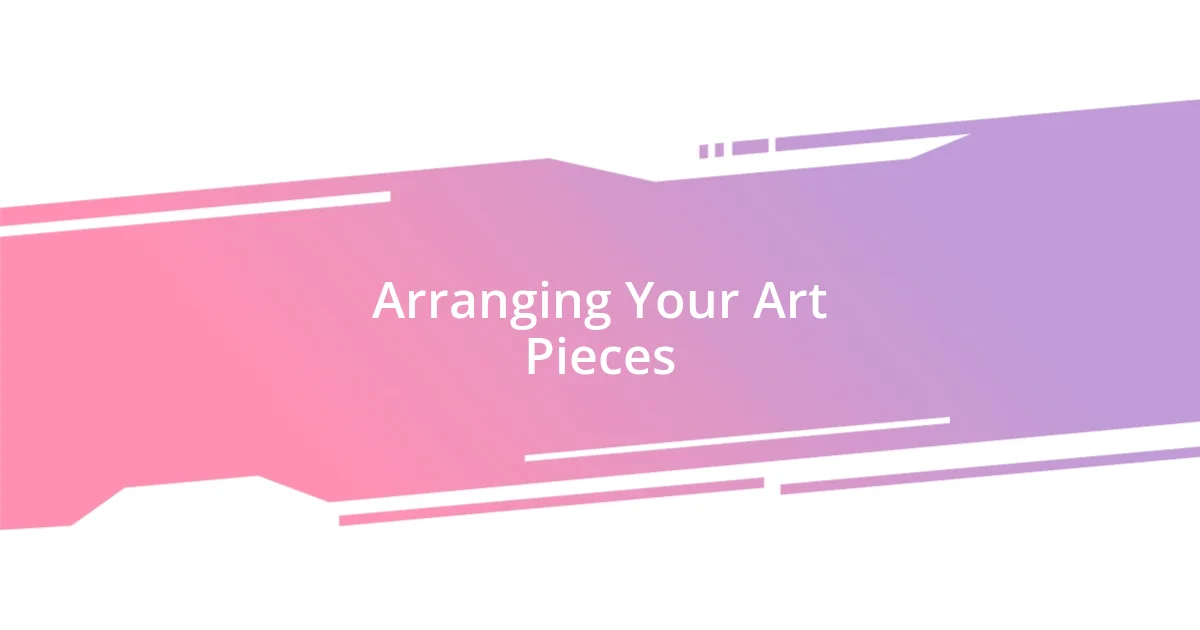Key takeaways:
- Plan your gallery wall by defining a cohesive color palette and theme that reflects your personal story and mood.
- Choose the right wall space by considering factors such as light exposure, visibility, proportion, and accessibility to create an inviting atmosphere.
- Add personal touches and unique items, such as family heirlooms or travel souvenirs, to enhance the emotional connection and storytelling of your gallery wall.

Planning Your Gallery Wall
When I first started planning my gallery wall, I was overwhelmed by the endless options. I remember standing in my living room, staring at a blank wall, and asking myself, “What do I want this space to say about me?” This moment of reflection helped me narrow down my vision and prioritize the mood I wanted to create.
Color and theme were crucial aspects of my planning process. I decided to stick to a cohesive color palette that complemented my existing decor, drawing me deeper into the planning stage. Selecting artwork that resonated with my personal story—like travel photographs from my favorite trips—gave the gallery wall a unique identity that brought me joy every time I walked by.
One tip I found helpful was to lay the pieces out on the floor before committing to the wall. This step made it so much easier to visualize the arrangements and play around with spacing. Have you ever rearranged furniture only to realize how freeing it can be? That feeling translates to wall art, too, encouraging experimentation until you find that perfect balance.

Choosing the Right Wall Space
Choosing the right wall for your gallery can truly transform the space. Think about the areas where you spend the most time or where you want to create an inviting atmosphere. Personally, I found that placing my gallery wall in the entryway instantly lifted my spirits every time I came home. It welcomed me with pieces that tell stories, reminding me of cherished memories right from the start.
When assessing the perfect wall space, consider these points:
– Light Exposure: Look for a wall that gets natural light, enhancing the artwork’s colors.
– Visibility: Choose a wall that is frequently passed or viewed, such as in a hallway or above a sofa.
– Proportion: Ensure the wall size is appropriate for your collection; a small selection can get lost on a large wall.
– Room Function: Think about how the artwork will influence the emotions of the space; a serene piece in a tranquil nook versus bold art in a lively area.
– Accessibility: Make sure the wall is easy to reach for future updates or rotation of art pieces.
I remember the feeling of excitement when I confirmed my choice—every glance at that wall sparked joy. It became not just a display, but a celebrated aspect of my home.

Selecting Artwork and Frames
Selecting the right artwork and frames can be both an exciting and daunting task. Based on my experience, I discovered that the artwork you choose should resonate with you personally. For instance, I picked a mix of bold abstract pieces and delicate black-and-white photography, each telling a different part of my story. It’s like curating an emotional landscape that reflects not just your tastes but also significant moments in your life.
When it comes to frames, I learned the hard way that they’re just as important as the art itself. Initially, I made the mistake of sticking to one frame style, thinking it would create harmony. But as I experimented with different textures and colors, I found a delightful interplay that added depth to my gallery wall. This variety helped the artwork breathe and stand out, rather than competing for attention. How do you want your wall to feel? Think of it as the personality of your space.
To help guide your selection process, I found it helpful to compare different types of artwork and frames. Here’s a simple comparison table that highlights some factors to consider when making your choices:
| Artwork Type | Frame Style |
|---|---|
| Canvas Prints | Simple Floater Frame |
| Photographs | Classic Black Frame |
| Posters | Colorful Wooden Frame |
| Art Prints | Elaborate Ornate Frame |

Arranging Your Art Pieces
Arranging your art pieces can feel like putting together pieces of a puzzle. I initially laid everything out on the floor to visualize how they might fit together on the wall. This hands-on approach allowed me to play with different configurations—moving pieces around until I found a balance that felt right. One evening, after several hours of trial and error, I finally found a layout that made my heart skip a beat, combining larger pieces with smaller ones to create a dynamic yet cohesive display.
As much as I enjoyed the creativity involved, the emotional impact of the arrangement truly surprised me. I realized that grouping similar themes or colors together heightened the overall vibe of the space. For instance, I clustered my monochrome photographs in a boxy format, which provided a striking contrast to the colorful abstracts nearby. Has there ever been a moment when an arrangement made you see something differently? For me, that moment came when I experienced how the right placement could evoke feelings of tranquility or excitement, shifting the entire atmosphere of the room.
Don’t forget the spacing between your pieces! I initially hung some artworks too close together, which created a cluttered look. After taking a step back, I adjusted the gaps for a more polished feel, allowing each piece the space to breathe. I typically recommend spacing of about 2 to 5 inches between framed pieces, depending on their sizes. The transformation was incredible; the wall felt lighter and more inviting. How does your artwork make you feel? I believe arranging it thoughtfully can amplify those emotions every time you walk past it.

Installing Your Gallery Wall
Once you’ve settled on an arrangement, measuring and marking where each piece will go is the next critical step. I can’t tell you how many times I underestimated the importance of getting it right the first time. With my heart racing, I carefully measured the distance from the ground and used a level to ensure everything hung straight. It felt immensely rewarding seeing my careful planning translate into a wall that perfectly showcased the pieces.
When it comes to installations, using the right tools can make all the difference. I learned this firsthand after a few mishaps with cheap hooks. Swapping in sturdy picture hangers and a reliable stud finder turned what could’ve been a frustrating experience into a smooth operation. Have you ever wrestled with a piece that just wouldn’t hang right? I remember almost giving up on a particularly hefty frame, but once I felt that satisfying thud against the wall as it finally locked into place, I knew I had made the right choice.
To minimize the mess, I recommend laying out the artwork on the floor one last time before making any holes in your wall. I did this and found that I could easily adjust the spacing and angles without any stress. There’s something magical about stepping back and seeing the entire setup come together in three dimensions. It reminded me that these little moments of patience can lead to a gallery wall that not only fills your space but also fills your heart with joy. How does that kind of deliberateness resonate with you? It’s amazing how joyfully intentional choices can bring a sense of ownership to your art collection.

Adding Personal Touches
Adding personal touches to your gallery wall is what truly transforms it into a reflection of your story. When I decided to include my grandmother’s old paintings, it wasn’t just about filling space; it was about evoking cherished memories. Each piece carries a fragment of my family’s history, reminding me of the countless afternoons spent admiring art together. Have you ever thought about how our past shapes our present decor choices? For me, that connection deepens my appreciation for the artworks displayed.
Incorporating mementos, like travel souvenirs or handcrafted items, can bridge the gap between art and personal memory. I still remember the little pottery piece I picked up in a bustling market abroad; every time I glance at it, I’m transported back to that vibrant day. This kind of layering—mixing art with personal gems—creates a rich narrative that invites guests to engage with the wall. It sparks questions and conversations. Does your wall tell a story? I find that when viewers can connect emotionally, it turns an ordinary gallery into a captivating experience.
Don’t shy away from playful experimentation with unique frames or other objects. I once framed a vibrant scarf that I wore at a remarkable event. It’s bold, but it holds sentimental value that stands out among the typical frames. This blend of unconventional choices fosters a uniquely personal environment. What quirky elements can you incorporate to elevate your gallery? I believe that these idiosyncratic touches not only reflect who we are but also add layers of intrigue and charm to our living spaces.














